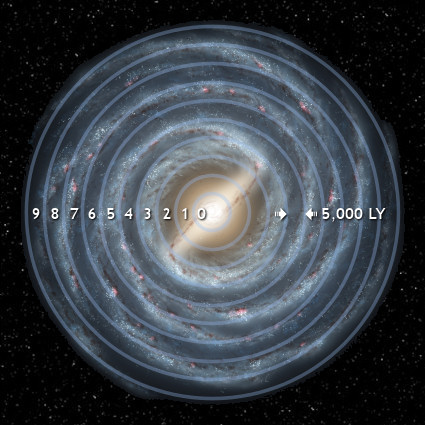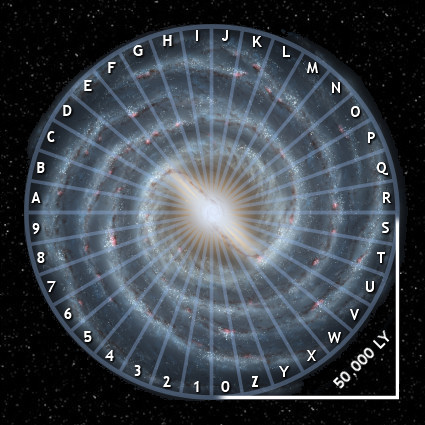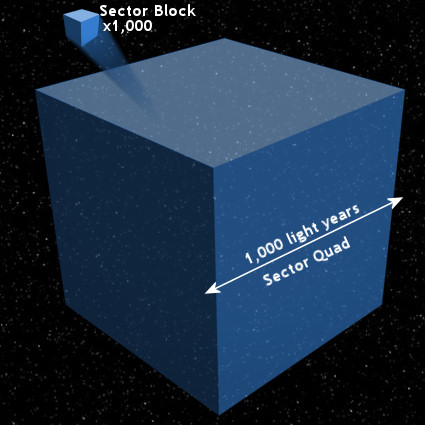| Sector Classification Guide |



| A sector zone is a concentric circle, 5,000 light years wide and 3,600 light years high. There are 10 sector zones in the Milky Way Galaxy. The second digit of a sector's designation is its sector zone. |
| A subquadrant is a wedge-shaped slice of the galactic disk. There are a total of 36 different subquadrants in the Milky Way Galaxy. Each one is 50,000 light years long, 3,600 light years high, and 8,727 light years across at its widest point. The first digit of a sector's designation is its subquadrant. |
The point where a subquadrant and a sector zone converge is called a sector grid. This division of space is approximately 5,000x5,000x3,600 light years. The sector grid designation for the Sol and Kilka Sectors, and most other Federation worlds is 15 (subquadrant 1, sector zone 5) A sector grid is further divided into 100 sector quads of equal volume. They are numbered 00 through 99, and represent the third and fourth digits of a sector's designation. |

| Each sector quad is even FURTHER divided into something called a sector block. On average, sector blocks are about 100x100x100 light years in size. There are 1,000 sector blocks in every sector quad, numbered from 000 to 999. These digits compose the next three digits of a sector designation. |
Finally, Sector Blocks are divided into 100 units
of 20x20x20 light years in volume. Labeled 00
through 99, they make up the final two digits in a
sector's designation. A typical sector in
Federation space contains between six and ten
star systems.
of 20x20x20 light years in volume. Labeled 00
through 99, they make up the final two digits in a
sector's designation. A typical sector in
Federation space contains between six and ten
star systems.
15 02 173 27
GRID
QUAD
BLOCK
SECTOR
The Kilka Sector's official designation is Sector
150217327. However, the Grid and Quad numbers
are frequently omitted in the designation, as most of
explored space lies within Grid 15 Quad 02.
150217327. However, the Grid and Quad numbers
are frequently omitted in the designation, as most of
explored space lies within Grid 15 Quad 02.
Hence, most sectors are referred to simply by their Block and
Sector designations (the Kilka Sector is thusly known as Sector
17327). Given this numbering system, the last five digits of a
sector designation are unique at a distance of at least 800 light
years, and the last two digits will always be unique for a
distance of 80 light years. Of course, many sectors are
commonly referred to by the name of a dominant star within
its boundaries, eliminating confusion even more.
Sector designations (the Kilka Sector is thusly known as Sector
17327). Given this numbering system, the last five digits of a
sector designation are unique at a distance of at least 800 light
years, and the last two digits will always be unique for a
distance of 80 light years. Of course, many sectors are
commonly referred to by the name of a dominant star within
its boundaries, eliminating confusion even more.